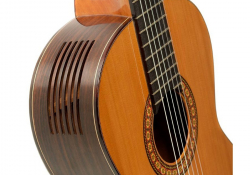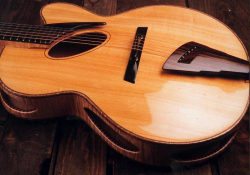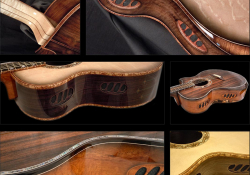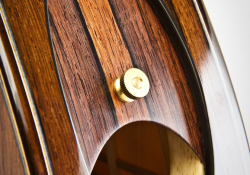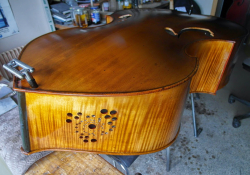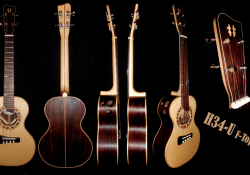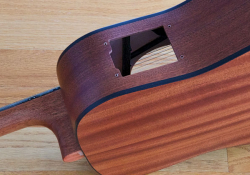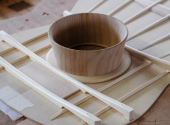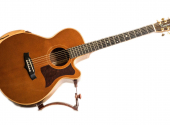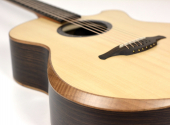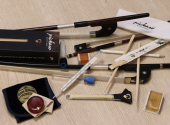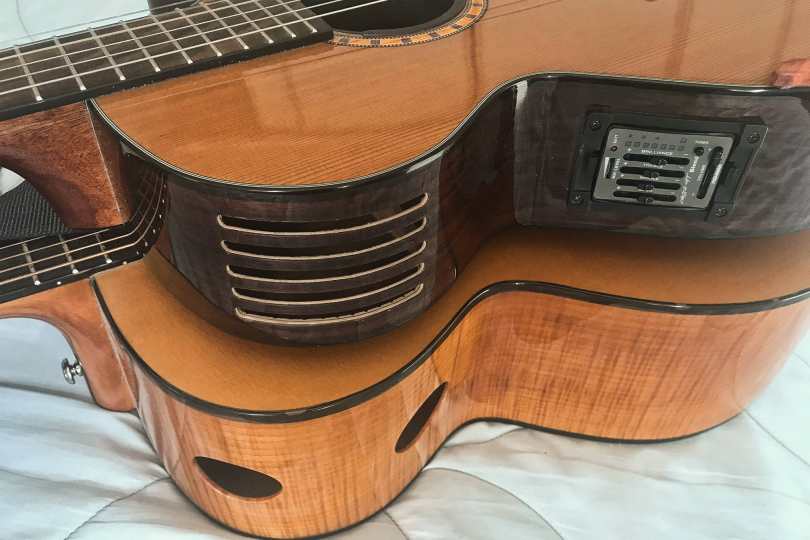
Laboratorium of Dr. Hyenik #5: Soundport
Another topic that has been stirring up the backwaters of the acoustic guitar realm quite a bit is "perforated sides". But, as usual, time is a great healer and in the meantime, the so-called soundports have become a standard not only for custom boutique guitar makers (producing guitars over 10 thousand dollars) but are gradually making their way into mass production as well, as for example the Taylor soundport demi-cutaway.
So what is a soundport or also called side port, sound reflector or personal monitor? Simply put, it's an added hole(s) in the guitar's sides. Why exactly would someone commit such a crime on a poor guitar? The main reason is actually quite prosaic, and most people have encountered it in practice. Your guitar, played by someone else (or maybe just picked up with a mic), suddenly has a different sound than you know intimately from your long hours of hard practice because, like it or not, the guitarists themselves don't hear authentic sound coming out of the soundhole, but only a more or less distorted reflection of it.
Apparently independently of each other, the famous Robert Ruck had the idea to add another sound hole to the side of a classical guitar, the even more famous John Monteleone did the same on a semihollow guitar, and the legendary Grit Laskin (whom we'll run into a few more times in the Laboratorium) on the "western" guitar, so that the guitarists could hear themselves better and more faithfully. Basically, it’s tripe, yet perfectly functional, that Monteleone developed into the ultimate Quattroport design with four sound holes, and Kevin Ryan into the design-perfect acoustic flutes, in which he combined two improvements at once and integrated a series of holes into the bevelled edge of the body (to be covered some other time).
The function of a kind of personal monitor is clearly the soundport's greatest asset. You simply hear yourself better, and it's a bit of a wonder that this is now taken for granted with the usually more conservative classical guitar. Masterful "Spanish" guitars have been equipped with soundports quite routinely, and no one gives them a second thought anymore. Whereas with flattop guitars with metal strings, this penetration has been used gradually, often conflicting with common sense, the logic of steel and the “college of life” of various internet wiseasses who, with full capslock deployment, save the world from any cracked sides and devaluation of great instruments with perforated nonsense, and spread their unfounded assumptions to the wide world with impunity. The best thing is when it makes you stop thinking about it and try it instead...
On the other hand, even the undeniable fact of better hearing your sound or its incomparably more spacious nature, as Taylor presents it, cannot be easily demonstrated, apart from personal experience, also due to imperfections of recording technique. Not to mention other positive effects, such as a louder or bassier sound due to the change in the Helmholtz resonance of the sound box. To be honest, I didn't notice it on my instruments and the airier manifestation mentioned by the guitar maker after the second perforation of my giant baritone (the first hole didn't work much when sitting down but only standing, so I dared to add a second one) is more a feeling than a fact. However, the guitar doesn't sound worse, my side hasn't cracked, and I can hear myself significantly better. Incidentally, I convinced my friend of this. He even had three additional soundports made when having a custom ukulele made, and he has nothing but praise for them – without them, he says, he wouldn't have been able to hear himself at all at rehearsals.
I tested the opening/closing with gaffa tape on my nylon, similar to the video above, and although there are unique designs that allow the soundport door to narrow/close, my "gills" will definitely stay open because the auditory perception was absolutely clear. The same conclusion was reached by master luthier and trainer Tom Bills, who states in his lessons, among other things, that he first started with a closable soundport, but gradually stopped making it because all customers leave the soundport open all the time anyway. I also like his comparison of the body of a guitar to driving in a car with one window open, which we all know – the air coming in (or leaking in the case of a guitar) starts to resonate very unpleasantly, which goes away if we at least slightly open another window (aka soundport).
Anyone interested in the scientific and technical details can revisit the physics with Alan Carruth, whose experiments with the so-called Corker guitar helped define the appropriate locations and sizes of soundports, or Tim McKnight, who carefully measured the effects on the volume of the guitar – and proved that even very complex and potentially crack-prone shapes with sharp edges work perfectly well.
If you find such an allotria drastically modern, I recommend browsing through a comprehensive publication on the history of stringed instruments and be surprised to find that the vast majority of these inventions have been tried in the distant past on many other instruments and only from time to time are they rediscovered in new contexts for the world.
I used to hear from cautious guitar makers that their guitars played better when they hadn't yet fitted a preamp in the prepared electronics hole, but the knowledge of irreversible intervention usually didn't beat the tradition. It took me a long time to commit too, but there's really no need to be afraid of the soundport. I'm going to have some of my other guitars perforated as well because, for me, it's definitely a positive shift for my ear and libido. I understand it seems like a pretty radical procedure, but there's no need to approach it too drastically. There are already many online tutorials on how to make a soundport both safe and beautiful, so the brave will be rewarded with a truer hearing of their play.
If you have found an error or typo in the article, please let us know by e-mail info@insounder.org.


